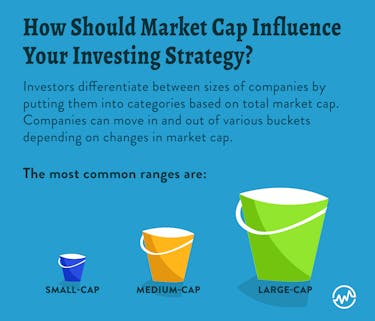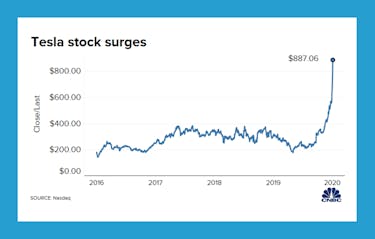

Get Access to 250+ Online Classes
Learn directly from the world’s top investors & entrepreneurs.
Get Started NowIn This Article
In 1954, Roger Bannister became the first person ever to run a mile under four minutes. This feat was previously thought to be unachievable. Bannister redefined what was possible, opening the door for other athletes to hit this mark. Since then, more than 1,400 athletes have broken four minutes in the mile. In business, the seemingly unacheivable feat was one trillion dollars in market capitalization — or market cap for short).
In August 2018, Apple (Nasdaq:AAPL) shocked the world by reaching a market cap of one trillion dollars on the stock market. Apple’s valuation surpassed the GDP of many countries including the Netherlands, Saudi Arabia, and Switzerland.
Like Roger Bannister and the 4-minute mile, Apple paved the way for other competitors to achieve this milestone.
In September 2018, Amazon (Nasdaq:AMZN) hit one trillion dollars in market cap. Microsoft (Nasdaq:MSFT) joined the trillion-dollar club in April 2019. Google (Nasdaq:GOOGL) became the fourth and most recent technology company to reach this unfathomable number in January 2020.
In the world of buying and selling stocks, market cap is a frequently cited metric. Knowing what it is, how to calculate market cap, and why it’s important can help investors make better investment decisions.
What Is Market Cap?
Market capitalization is the total value of a firm’s outstanding equity shares based on current share prices and number of shares outstanding.
Market cap, or the total value of a firm’s equity, represents the relative size of the company. Because it is the ‘market value’ of the firm, the value can change based on market sentiment.
A company’s share price is the dollar amount that one share of stock can be bought or sold at. The share price is constantly changing based on the supply and demand of a company’s stock.
Shares outstanding refers to all public shares currently owned by stockholders, employees, and investors. Typically, these shares can be bought and sold in the form of stock on the stock market. Shares represent equity or a piece of ownership in the company.
Knowing how to calculate market cap — which we’ll explain next — is important for your investing strategy.
How To Calculate Market Cap

The calculation for market cap is simple: the price per share X number of shares outstanding.
For example, if a stock is trading at $20 per share and there are one million shares outstanding, then the market cap for that company is $20,000,000.
While share price is recognized as the main reason for changes in market cap, companies can also issue or sell additional shares. Companies issue shares to raise money from investors for additional capital. This money is then used for the development and growth of their businesses.
While share price is a key driver, make sure to be on the lookout for share issuances when analyzing changes in market cap.
Market cap is very important in how investors categorize companies and forms the basis of major stock market indices. The S&P 500 index is made up of the largest 500 US companies by market cap. The FTSE 100 index includes the largest 100 companies listed on the London Stock Exchange by market cap.
A company’s most recent basic shares outstanding count can be found on the first page of its 10-K or 10-Q. The stock price can be found on any major financial news source. Financial news websites like Yahoo Finance, Google Finance, and Seeking Alpha will also include the market cap as part of a company’s stock ticker.
How Should Market Cap Influence Your Investing Strategy?

Investors differentiate between sizes of companies by putting them into categories based on total market cap. Companies can move in and out of various buckets depending on changes in market cap. The most common ranges are denoted as small-cap, medium-cap, and large-cap.
Large-Cap Companies
This bucket consists of companies that have market caps between $10 billion and $200 billion. These companies are also known as blue-chip stocks and are some of the most famous companies in the world.
If you want examples of large-cap companies, look no further than the Dow Jones stock market index which consists of 30 large-cap companies including:
- American Express (NYSE:AXP)
- McDonald’s (NYSE:MCD)
- The Walt Disney Company (NYSE: DIS)
Large-cap companies are considered large, stable companies likely to be around in the long-term. Most of these companies have a history of price appreciation and paying dividends.
Many conservative investment strategies like value and income investing include large-cap stocks in their portfolios since they provide predictable returns and a steady stream of income.
Mid-Cap Companies
This bucket consists of companies that have market caps between $2 billion and $10 billion. Mid-cap companies are typically less stable than large-cap companies but have greater opportunities for growth.
Examples of mid-cap companies include:
- Dollar Tree (Nasdaq:DLTR)
- NuSkin Enterprises (NYSE:NUS)
- Snap Inc. (NYSE:SNAP)
Mid-cap companies are generally riskier than large-cap companies but have a more proven track record compared to small-cap companies.
Mid-cap companies with a strong financial profile or opportunities for growth should be a part of any investor’s portfolio.
Small-Cap Companies
This bucket consists of companies that have market caps between $300 million and $2 billion. Many small-cap companies are younger and in the early stages of the business lifecycle.
Examples of small-cap companies include:
- Century Casinos (Nasdaq:CNTY)
- Papa John’s International (Nasdaq:PZZA)
- Southwestern Energy Co (NYSE:SWN)
Small-cap companies tend to be riskier and have larger price fluctuations than large-cap and mid-cap companies. However, these smaller companies also can offer more growth potential.
Many growth investing strategies include small-cap stocks in their portfolios. These strategies include more aggressive approaches, focusing on companies that offer the potential for rapid growth and huge upside potential.
The Importance of Diversification
There are no clear investment winners related to market cap. Small-cap, mid-cap, and large-cap stocks all have outperformed each other and the market. Large-cap, mid-cap, and small-cap stocks perform better in different environments, too.
That’s why it’s important for investors to diversify and maintain a mix of different sized companies in their portfolios.
The size of the company, whether small, medium, or large-cap, can serve as a good benchmark for shaping your investing strategy. Finding the right blend will help reduce investment risk and maximize portfolio returns.
Importance of Market Cap to Investors

Market cap is a widely used metric that reflects the expectations of investors about the firm’s future performance. Market cap can help to determine overall market sentiment and outlook for both the company and the broader industry.
If the market cap of a company increases, this is most likely due an increase in share price. This increase in share price can be due to multiple factors, including:
- solid earnings reports
- unexpected positive events
- operational improvements
- or an overall strong economic outlook
If market cap decreases, this is most likely due to a decrease in share price. This decrease could be the result of:
- company-specific issues
- missed earnings guidance
- underperformance versus its competitors
- or a weak economic outlook
Word of Caution
It is important to note that market cap alone cannot determine whether buying a stock is a good or bad investment.
Market cap measures the size of the company at a point in time. If the market cap increases, this doesn’t guarantee that a company is going to perform well in the future.
The stock market is highly efficient, meaning that public companies are generally priced at their expected value based on all public information provided. Investors can typically expect a market cap to reflect the intrinsic value of a company. The intrinsic value is the value that a rational investor with full knowledge about the stock’s characteristics would willingly pay.
Investors will buy stocks for which they think intrinsic values are greater than market values and sell stocks for which they think intrinsic values are less than market values.
Being able to analyze changes in market cap is an important tool, but is only one factor in determining whether or not a stock is a good investment.
Importance of Market Cap To Public Companies
Market cap plays a very important role in the success of a public company. A company’s market cap can determine:
- what stock exchange they’re on
- the amount of capital they can spend
- the types of investors they attract
Paying close attention to how a change in market cap affects a company can help an investor determine whether to buy or sell their stock.
Listing On Stock Exchanges
Companies that trade on major stock market exchanges like the NYSE and Nasdaq are in an exclusive league comprised of the most famous and influential companies in the world. Companies can only be on these listings if they meet multiple requirements including meeting a total market cap threshold.
To qualify for a NYSE listing, a company must have at least 1.1 million shares of publicly traded stock and a market cap of at least $40 million.
To qualify for a Nasdaq listing, a company must at least 1.25 million shares of publicly traded stock and a market cap of at least $50 million.
Meeting these market cap requirements can provide more access to more accredited investors, improve a company’s reputation, and lead to a big increase in stock price.
Delisting from Nasdaq, the NYSE, or another exchange can occur when a company’s market cap falls below the exchange’s requirements.
Although a company is not necessarily in bankruptcy when it is delisted, it has typically lost some of its financial strength, credibility, and/or stability. Delisting from an exchange can lose investors significant money.
Advantages Of Increasing Market Cap

To further explore the importance of market cap, let’s dive into the advantages companies experience when share price and market cap increases.
Increases Access To Capital
If a company wants to raise capital to grow their business, they can now do so by selling shares at a higher price to increase cash balance. This encourages companies to invest in new products or services, finance operations, make acquisitions, and expand into new markets.
Improves Balance Sheet And Pays Down Debt
A company with a higher market cap is usually more stable and secure than a smaller company, giving it access to more favorable financing terms. Higher market cap values also allow companies to pay down debt with cash received from selling shares at a higher price per share.
Unlocks Value For Stakeholders
Executives, employees, and other stakeholders benefit through option grants, employee stock ownership plans, retirement plans, and other means.
Attracts Accredited Investors
An increasing market cap generates interest and exposes a company to a large pool of investors. Larger market cap values can help cement a company’s reputation as a successful, valuable business.
At the end of the day, when a company wins, the investor wins. Understanding how market cap values can either benefit or harm a company’s investment value provides more insight into buying and selling stocks.
Market Cap Case Study: Tesla
From 2019 to 2020, Tesla (Nasdaq:TSLA) saw an explosive increase in market cap. In six months, from August 2019 to February 2020, Tesla’s market cap increased by more than 250%.
Tesla became the first U.S. automaker to hit a $100 billion market cap. That’s now grown to more than $140 billion — almost twice the combined size of rival automakers General Motors ($48 billion) and Ford ($36 billion). Only Toyota has a higher market cap at this point.
Tesla’s vast increase in market cap is a result of an increase in global vehicle sales, the introduction of Tesla vehicles in China, the construction of two Gigafactories in China and Germany, and a stellar Q4 earnings report.
Tesla’s increase in market cap sent shockwaves through the stock market. Less than a year ago, Tesla was the most shorted stock on Wall Street, meaning that most investors were betting that the share price would fall. In 2019, Citron Research estimated that Tesla’s share price would fall to under $100 by year-end.
Since then, analyst firms like Wedbush Securities, Argus Research, and ARK Investment Management have increased future share price estimates to unprecedented numbers. ARK Investment Management believes the stock could hit up to $7,000 per share by 2024.
Tesla’s share price increase has unlocked value for investors. CEO Elon Musk is the company’s biggest shareholder and has become one of the richest people in the world in the past six months — Tesla’s share price gain pushed his net worth to $39.3 billion
What Has Tesla Done?
Tesla has been quick to take advantage of this market cap increase. In early February 2020, Tesla announced that it plans to offer $2 billion of common stock. Due to its higher market cap, Tesla can raise the money by selling less shares for the same cash value.
Tesla said it plans to use the proceeds “to further strengthen its balance sheet, as well as for general corporate purposes”.
CEO Elon Musk will buy as much as $10 million of stock in the offering emphasizing his confidence in the company.
Overall, Tesla’s historic run has cemented it as a powerhouse in the auto industry and instilled confidence in investors, analysts, and stakeholders. Tesla is also taking advantage of the situation by unlocking further capital to invest in future growth.

How To Calculate Market Cap
Knowing how to calculate market cap and analyzing it — by itself — isn’t effective to make intelligent investments.
However, understanding the size of the company in the context of an overall investment strategy is crucial in building a balanced stock portfolio to manage both risk and return.
Companies like Tesla will continue to innovate and shift how investors buy and sell stocks in the stock market. The “gold-standard” may be a one trillion-dollar market cap today, but as we’ve seen, it takes just one company to come in and redefine what is possible, benefiting companies and investors alike.






